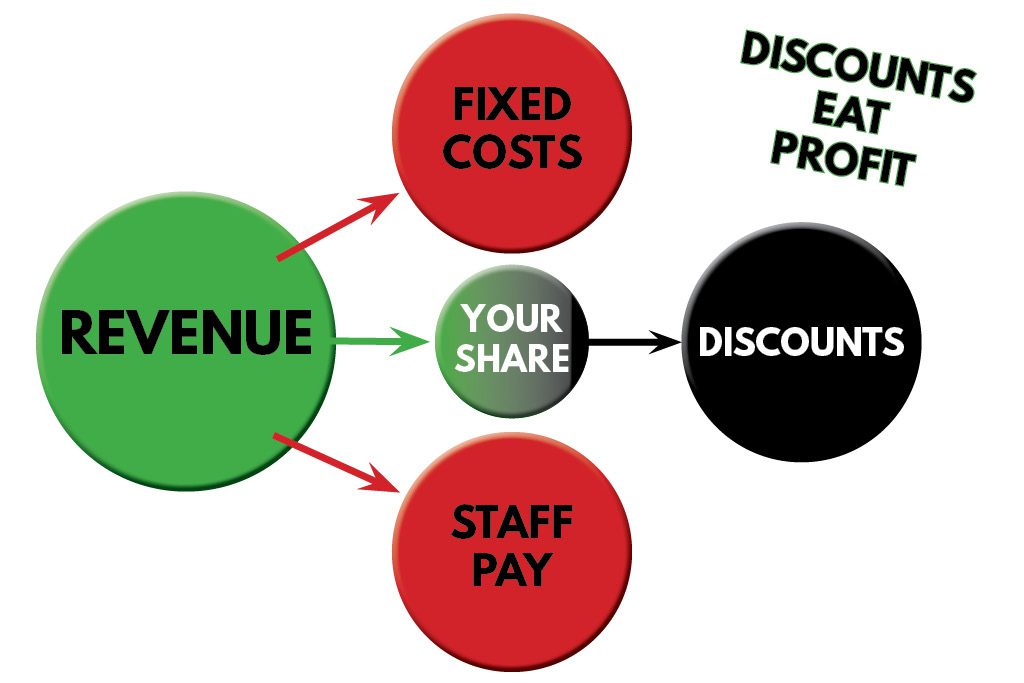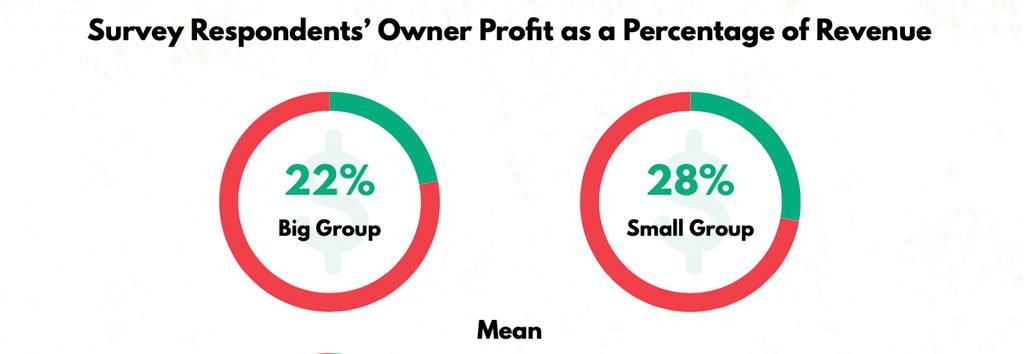Let’s say you sell your coaching services for $225 a month.
Your profit margin is 30 percent, so as owner you earn $67.50 after the landlord, the government, the utility companies, the staff and everyone else gets paid.
You’d like to get more clients on Black Friday, so you decide to offer a 15 percent discount.
Question: Where does that money come from?
Answer: It comes from your share.

By slashing your profit margin, you earn less and your family earns less.
Instead of earning $67.50 for helping a client improve health and fitness, you get $33.75. Half.
But you’re not going to give 50 percent effort, and you’re not going to spend less time on discount clients. You’re going to deliver the same great service—you’ll just earn half as much.
This math is based on selling training services at $225 a month. Most gyms don’t do that. They don’t understand their own value and can’t communicate that value to clients, so they’re already discounting their services with regular prices that are far too low.
In 2024, the average big group gym takes in $167 per client per month (average revenue per member, or ARM), according to our “State of the Industry” report. That same study revealed the average gym’s profit margin is 22 percent.


Here’s the math:
- $167 at a profit margin of 22 percent is $36.74.
- 15 percent Black Friday discount: $25.05
- After-discount profit: $11.69
This is bad. If you’re only making $11 per client, you need a lot of clients. So you need a lot of space, a lot of equipment, a lot of staff, a lot of marketing—it spirals very fast.
I’ll take it one step further to drive the point home:
- ARM of $140 (numbers like this are far too common).
- Profit margin of 16 percent.
- Profit of $22.40.
- 15 percent Black Friday discount: $21
- After-discount profit: $1.40
You might look at this last scenario and think “who would do such a thing?”
Far too many gym owners do exactly this because they make two monster mistakes.
1. They don’t know their numbers, so they can’t do the math and discover that a discount is a horrible idea. Example: I know a gym owner who gave a certain group of members a 50 percent discount. They paid about $5 per class, so when three of them were the only clients in a morning session and the coach got paid $20, the owner had to cover the wage and fixed-costs shortfalls personally. He was literally paying for his clients to train, and he was working 14-hour days.
2. They think that if they sell more memberships, they’ll make up the discount in sales volume. Except it never works out like that. It’s hard to acquire and retain a huge number of clients. And—let’s be real—if you have low rates to start, after-discount profits are tiny, and multiplying them with new clients doesn’t solve your money problems.
One final issue: If you discount your rates for amazing service, it starts to make your service look “cheap.” That’s not what you want if you sell coaching. You don’t want to train bargain hunters for three months; you want to train people who see your value and will pay your rates for years because you’re helping them accomplish their goals.
And you definitely don’t want your current members to ask, “Why does New Guy get a discount when I don’t?”
I make this no-discounts argument every year at this time because discounts kill gyms. We have the data. This is not hyperbole.
If my message has hit home, here’s how you start telling people that the price is the price.
Say This Stuff
1. “We don’t have discounts.”
Just say this when someone asks for a discount. Keep it simple. This line solved the “discount problem” at my gym almost a decade ago.
2. “We don’t play those games.”
Use this one when another gym is giving discounts.
Because the nature of discounts is subjective (it requires a human “decision” instead of an automated process), it’s always easy to cast doubt on the intent on the discounter.
When I was selling high-end fitness gear, we were always in a losing price battle against Sears and other department stores that ran frequent “sales” on treadmills. So when someone requested that we match a price or asked when we’d have a 40 percent off sale, we’d say, “We don’t play those games.”
It worked: You could see a visible shift in the purchaser as they became suspicious of the chains offering the discount. It helped that one of the department stores was sued for advertising a regular price on tires that it never actually charged—they were always on sale. I occasionally brought that up.
3. “We treat all our service professionals equally well because we know our service is critical for your safety.”
Members of some service groups receive discounts from other businesses, so they’re inclined to ask for them. The line above is the best one to use.
The service you provide to military personnel, police officers, firefighters and other safety workers isn’t five bucks off: It’s keeping them alive. Remind them (gently), and use the peer anchor if you need to: “No one else gets a discount, and you don’t want to be different from the crowd, do you?”
Bonus: If you’re a former soldier/cop/firefighter who owns a gym, you’ve sacrificed enough (thank you for your service). You should be paid fairly for your work.
4. “This rate is as inexpensive as possible for this level of service.”
Use this when someone asks why you’re more expensive than other local gyms.
First, don’t ever say “cheap” unless you’re talking about the competition.
Second, you’re sticking a wedge into the conversation: “for this level of service.” That phrase should prompt an opportunity for more explanation. But don’t expand unless asked.
Additional Advice
Don’t over-explain. All these responses consist of one sentence. The more words you use, the more handholds you give the person asking for a discount.
Keep it black and white. If you give a discount for one person in your gym, you’re ripping off everyone else.
Remember that your primary duty is to your current clients. Scrambling to recruit new clients with discounts your current clients can’t get is a breach of trust.
Don’t run through all the scenarios in your head before a conversation starts. You’ll be trying to “remember lines” instead of giving honest answers, which come naturally. Especially if you use response No. 1 above, communication is easy and transparent.
If they say “I’ll go join the cheaper gym,” that’s good. You don’t want everyone. Don’t pour your knowledge and care into fickle clients who are only after the cheapest rate.
Finally, don’t presume anyone wants a discount. This is the No. 1 error business owners make: We project our own budgets onto other people.
Lower Prices Require More Clients
Every time you give a 20 percent discount, you increase the number of clients you need to reach your perfect day.
You weaken your business and impoverish your family.
You know why no one ever asks me for a discount?
We don’t give any.

